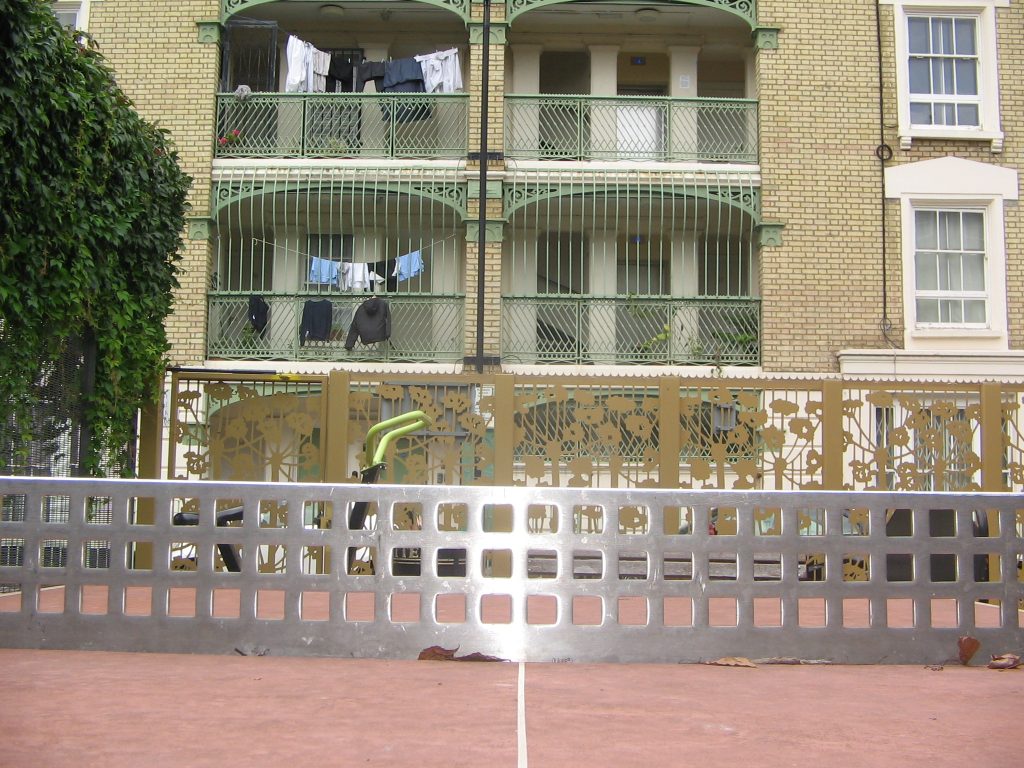
I pass by there on occasion, and the golden fences with the old facilities inside always make me look sideways. Wicklow Street strikes me as very different from the trendy and edgy King’s Cross station. It’s tired and old, and the other end of the street sits on badlands near King’s Cross station, symbolising a bygone era (OWARDKX 2021). Inspired by Georges Perec, I began to look at this mundane and aging corner of the neighbourhood, Wicklow Street Open Space.
Inside this open space are two wooden chairs, a slide, a Ping-Pong table, a swing, a circular play structure, two small children’s playhouses and an outdoor exercise bike. However, I don’t feel that these objects in the physical sense alone create such a tranquil and unique atmosphere. What matters is that there are also the people who inhabit the Derby Lodge across the street. It’s the interaction between people and space like this that shapes the character and soul of this neighbourhood (Perec 1974). So I began to focus my research on some of the outcomes of the interactions, such as trash and traces. I used an old camera to document everything. I initially concentrated on superficial details, such as where the traces came from. (The circular traces on the wall are from pickleball.) How long have they been there? What is most of this garbage? The majority of this open space is filled with snack packages and cigarette butts. In a small playground for children, some things seem out of place. After watching Agnès Varda’s (2000) <The Gleaners and I>, I was determined to gather stories from the neglected or discarded things within the venue. On October 7th, I spent two hours recording everything that was going on at the site and a portion of the street outside of it, including people passing by, what they were wearing, vehicles, behaviour when entering the playground, and so on. Before and after beginning this act of observation, I documented some of the items left behind and new additions to the site. Initially, I planned to create something similar to a collection archive, but after a few more days of research, I decided that a ‘map’ would be a better way to express the development process. We tend to think of maps as fixed, but it can be as fluid and dynamic as the world it represent (Obrist and McCarthy, 2014). It relayed several momentary recollections of human behaviour that I had observed in the open spaces of this community. It made sense, I thought. I’ve been there several times since then, but I think it’s still everything about that day that better captures some of the social connections and memories.
All of the characteristics of this ‘peaceful ” “old’ open space include not only the physical space, but also the stories of the everyday neighbours who live there. I attempted to describe these ‘candy papers’, ‘broken draft paper’, and ‘plastic bottle caps’ in black and white using twisted and jittery graphics. And thinking about which ones should go in the trash? And what are the items people leave behind? What items are related to the people who live in Derby Lodge across the street? What items are related to the addicts who sell drugs here? Like a ‘gleaner’ in the words of Varda (2000), I observed and dissected the stories in this space and began to map the general human movement. By the time I opened the playground gates to leave, I was wondering again: could someone at Derby Lodge be watching me sit in this space?
- Obrist, H.U. and McCarthy, T. (2014) Mapping it out : an alternative atlas of contemporary cartographies. London: Thames & Hudson.
- OWARDKX.(2021) The End of King’s Cross? [online]Available at: <https://savebloomsbury.co.uk/2021/01/13/the-end-of-kings-cross/>[Accessed 17 October 17, 2024]
- Perec, G.(1974 )‘The Street’, ‘The Neighbourhood’ and ‘The Town’ from Species of Spaces and Other Places.
- Varda, A. (2000) The Gleaners and I.
Leave a Reply